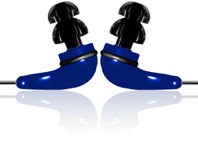|
Getting Ready:
First off, I started by reading the Head-Fi.org (a web forum dedicated to portable hi-fi audio and high-end headphones) thread discussing these ear buds; they recommend that before judging them, I should begin by first making sure that the tips fit my ears. Makes good sense - if it can't seal, it can't move your eardrum, and all the bass leaks out. Second thing they recommended was that I 'burn in' the ear buds by running pink noise through them for nine hours at slightly above normal listening volume; after that, the sound produced by them should not change with use. I downloaded the pink noise sample from Wikipedia, and set it as a playlist on my iPod. The headphones were plugged into the iPod dock's line out, and the playlist was looped overnight. At the nine hour mark, the iPod was stopped, and the headphones removed for testing.
A Closer Listen:
After their burn-in, these ear buds were pulled aside with a tone generator and all of the tips to test for fit. As expected, the rubber flange eartips managed a consistently poor seal with my ears no matter the size, and bass tones were consistently muted - except for an occasional moment where the stars (and my ears) lined up, and I got a taste for the true power of the Atrio. That kept my interest until I moved on to the disposable foam tips. I was thoroughly surprised when the large 'foamies' proved the most comfortable in my ears, reliably keeping the plastic sound tube from crashing into the back of my middle ear and causing pain. Interestingly, the small tips were second best; the medium ones combined the worst of both worlds for me.

After the fit test, I queued up a playlist of mixed electronica, Metallica, and symphonic for the listen test. My goal here was to find music that tested the extreme lows and extreme highs the drivers were capable of producing (the electronica), the punch and tooth-loosening thump they could generate (Metallica), and the linear response from low to high - making sure that there weren't any frequencies in the middle that were being dropped, and generally that the same signal strength produced the same perceived volume at low, high, and everywhere in between (the symphonic). The first thing I noticed when comparing these to the Sennheiser HD-280 Pro (commonly bought as entry-level 'audiophile' headphones, and an excellent baseline for comparison) is that these Atrios were deep. Bass notes were satisfyingly husky, and they rolled off very sharply at the headphones lower limit. This limit, by the way, was not quite as deep as the Sennheisers' legendary 8Hz, but it was much more pronounced until it hit the wall - and it was in the same ballpark, comfortably below 20 Hz to my untrained ear. (FutureSonics claims 18 Hz, by the way, but does not publish specifications regarding frequency response curves - since the ear canal becomes a resonant cavity, they argue, it is either unfair or dishonest to compare it directly to larger headphones that can produce bass notes without an airtight seal) The Sennheisers however, are legendarily 'bright' sounding; bass is amazingly deep, but not very loud - this can be fixed with a proper equalizer, but such workarounds proved unnecessary on the Atrio. Why is this important? On many MP3 players, a proper equalizer is nowhere to be found, with presets like "Deep" and "Bass Booster" standing in for proper adjustment, and many home stereos only have dials for "Bass" and "Treble". The Atrios quite simply produce your music, the way it was meant to sound. You may be surprised at what you've been missing.
On top of their impressive quality, FutureSonics' experience with in-ear monitors for stage use shows in the build quality of these buds - having carried these with me in my laptop case daily for three months, the only sign of wear or use they exhibit are dirty foamies. At the time of this writing, replacements are $15 for ten at the FutureSonics store for accessories, and the tips are reportedly cross-compatible with Shure's. These are about the same price, but their rubber tips have three flange seals, and their foamies are rounded at the end - so if you love the sound but hate the fit, you have some flexibility. The real good news comes when you decide you're ready to upgrade - FutureSonics works with audiologists to produce custom 'SoftWear' sleeves made to fit your ear canals perfectly - and HeadFi users who have sent off for them report them amazingly comfortable, and not only no lack of bass, but an overall improved sound quality. It should also be noted that FutureSonics plates their headphones mini-plug with gold in order to prevent signal-degrading corrosion - this will keep the water in the air from slowly damaging the plug over time and reducing sound quality. One final note - the foam eartip I favor seems to provide about 20 dB of noise isolation - while you can still hear the outside world, it will be muted. This is good in that it allows you to hear details at low volume so you don't burn out your eardrums. This is bad in that it can prevent you from hearing something important - car engines, cries of "Look out!" or "Duck!" spring to mind. While not a problem, this does bear mentioning.
OUR OTHER RELEVANT REVIEWS




